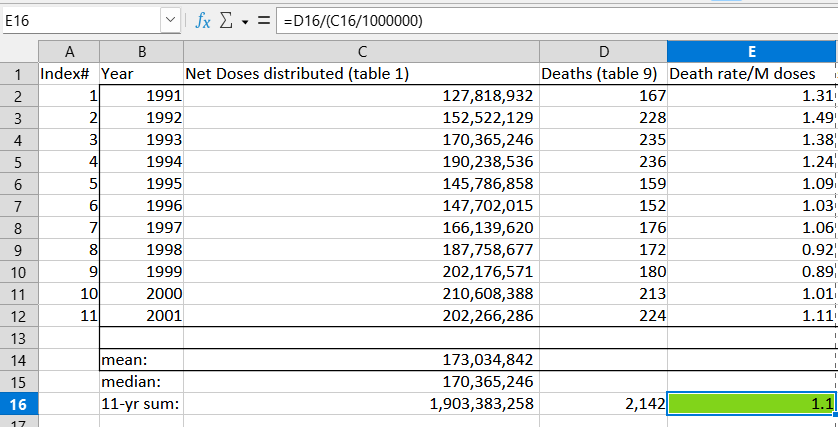Rational Vaccination
Post #1310
EDIT: The post has been edited from the original.
To qualify as being rational, a vaccine has got to prevent more deaths than it causes. There is a saying that hindsight allows for 20/20 vision, so that you can see if the benefits you had achieved in the past were really and truly worth the risks you had taken in order to obtain them.
When looking at the past risks faced, one place to start is with VAERS adverse event reports (AERs), though after obtaining an estimate of AERs, a correction is required in order to counter the under-reporting found in the VAERS system. For vaccines in general over an 11-year time-span, there were 1.1 fatal AERs per million doses:
The formula for cell E16 shows up at top, and it is the total number of fatal AERs for the 11 years, divided by the total number of net doses distributed for those 11 years, itself divided by a million — resulting in a reporting rate of 1.1 fatal AERs per million doses. But recall how a correction is needed for the under-reporting of VAERS.
A conservative estimate on the capture rate of serious adverse events, such as death, for spontaneous reporting systems is to use the 75th percentile capture rate of all AERs — where it is assumed that the VAERS system successfully captures 18% (under-reporting = 82%) of all of the underlying serious AERs, such as fatal AERs:
With 82% under-reporting, then you capture 18% of the events that occur in the background. Applying that correction to the original fatal reporting rate of 1.1 per million doses of general vaccines yields (1.1/0.18=) 6.1 actual fatalities caused per million doses.
But if vaccines are a type of thing which cause ~6 deaths per million doses, then they should only be approved for diseases which, themselves, cause at least 6 deaths per million. This is the only way to guarantee that, on average, the vaccine causes less death than it prevents — assuming 1 yearly dose and 100% vaccine efficacy on it.
Assuming 100% efficacy, when was the last year that measles vaccination would have been rational? To find out, we use the above estimate on the average rate of death caused by vaccines in general from 11 years of historical data along with a correction for under-reporting:
6 deaths caused per million doses
And then we find the last year when measles was responsible for at least that many deaths:
The last year that measles was responsible for at least 6 deaths per million — or 0.6 deaths per 100,000 — was 1949:
[click to enlarge]
And given how hindsight allows us to ascertain the risk of vaccination in general — ~6 deaths caused per million doses — we can reach the conclusion that 1949 was the last year when it was rational to implement measles vaccination, assuming a new dose is required each year. Keep in mind that measles vaccination did not begin until 1963.
In the first year of a dose, it is rationally expected that measles vaccine will cause more death than measles. Because the dose is a two-dose series (MMR below), there will be another year when measles vaccine will cause more death than measles would have:
Though the “dose-years” cause more death than they prevent, sustained protection is possible, leading to net protection when looking over decades. After 1949, measles vaccine became a “bad gamble” in that it is expected to cause more death than it prevents — at least for the year that you take it. Immunity wanes 2-4% per year.
In theory, you can have a net gain from measles vaccination if you live long enough — but that depends heavily on the background rate of measles fatality, which had reduced to just 2 yearly measles deaths per million by 1960. When the expected death from measles is 2 per million, then taking a vaccine that kills ~6 per million is a bad gamble.
You have to make sure that you live long enough to enjoy the reward for the risk that you took. The main point of this essay is to call attention to the average rate of caused death from vaccines, so that we can know when it is rational to come out with new vaccines (i.e., when the background rate of death by a disease reaches 6 per million).
The only way to really know — i.e., to know “for certain” — that a vaccine in the near-to-middle term is beneficial, on net, to humankind is when the pre-existing disease it is aimed at is something that had already been killing at least as much people as the vaccine is expected to kill. Vaccines, in general, are expected to kill 6 per million.
Reference
[historical VAERS data] — CDC. https://www.cdc.gov/mmwr/preview/mmwrhtml/ss5201a1.htm
[for spontaneous reporting, the 75th percentile capture rate is 18%] — Hazell L, Shakir SA. Under-reporting of adverse drug reactions : a systematic review. Drug Saf. 2006;29(5):385-96. doi: 10.2165/00002018-200629050-00003. PMID: 16689555. https://pubmed.ncbi.nlm.nih.gov/16689555/
[1949 was the last year that measles caused as much death as vaccines do] — https://www.cdc.gov/nchs/data/vsus/vsrates1940_60.pdf
[childhood vaccine schedule] — CDC. https://www.cdc.gov/vaccines/imz-schedules/downloads/parent-ver-sch-0-6yrs.pdf






